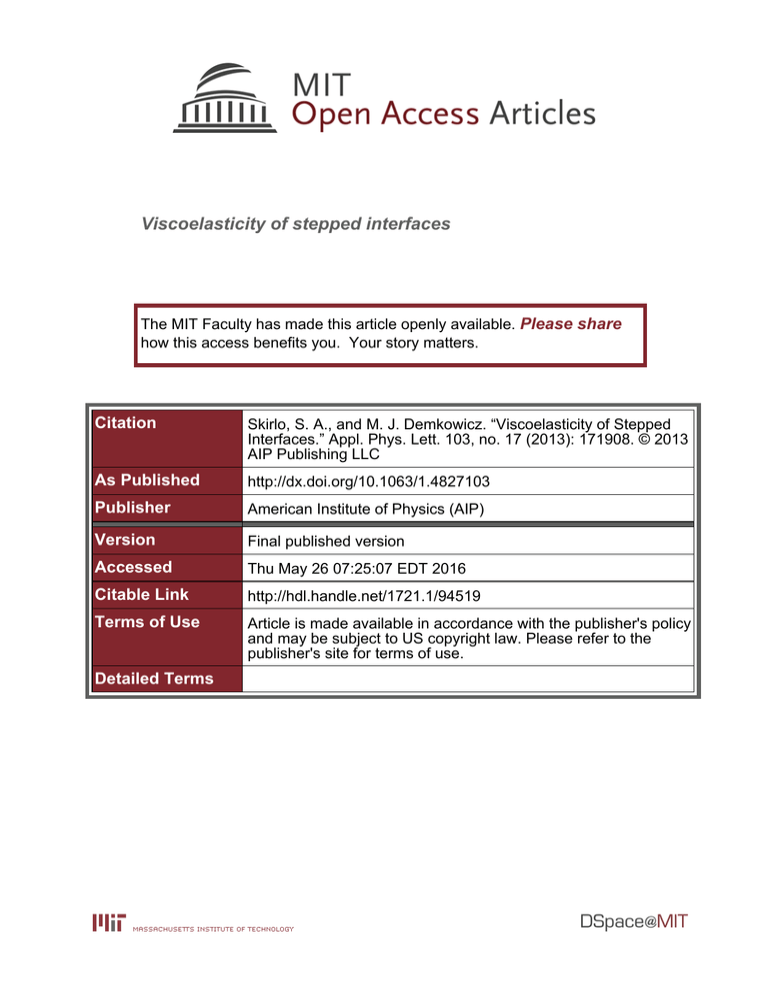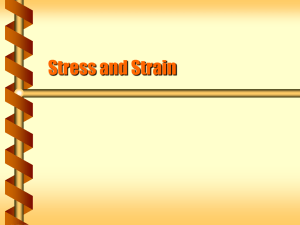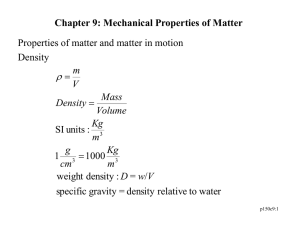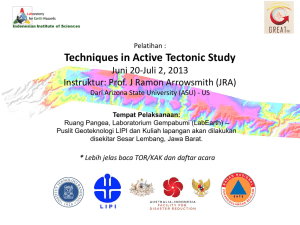Viscoelasticity of stepped interfaces Please share
advertisement

Viscoelasticity of stepped interfaces
The MIT Faculty has made this article openly available. Please share
how this access benefits you. Your story matters.
Citation
Skirlo, S. A., and M. J. Demkowicz. “Viscoelasticity of Stepped
Interfaces.” Appl. Phys. Lett. 103, no. 17 (2013): 171908. © 2013
AIP Publishing LLC
As Published
http://dx.doi.org/10.1063/1.4827103
Publisher
American Institute of Physics (AIP)
Version
Final published version
Accessed
Thu May 26 07:25:07 EDT 2016
Citable Link
http://hdl.handle.net/1721.1/94519
Terms of Use
Article is made available in accordance with the publisher's policy
and may be subject to US copyright law. Please refer to the
publisher's site for terms of use.
Detailed Terms
Viscoelasticity of stepped interfaces
S. A. Skirlo and M. J. Demkowicz
Citation: Appl. Phys. Lett. 103, 171908 (2013); doi: 10.1063/1.4827103
View online: http://dx.doi.org/10.1063/1.4827103
View Table of Contents: http://apl.aip.org/resource/1/APPLAB/v103/i17
Published by the AIP Publishing LLC.
Additional information on Appl. Phys. Lett.
Journal Homepage: http://apl.aip.org/
Journal Information: http://apl.aip.org/about/about_the_journal
Top downloads: http://apl.aip.org/features/most_downloaded
Information for Authors: http://apl.aip.org/authors
APPLIED PHYSICS LETTERS 103, 171908 (2013)
Viscoelasticity of stepped interfaces
S. A. Skirlo1,a) and M. J. Demkowicz2
1
Department of Physics, Massachusetts Institute of Technology, 77 Massachusetts Avenue, Cambridge,
Massachusetts 02139, USA
2
Department of Materials Science and Engineering, Massachusetts Institute of Technology, 77 Massachusetts
Avenue, Cambridge, Massachusetts 02139, USA
(Received 14 August 2013; accepted 11 October 2013; published online 24 October 2013)
Using molecular dynamics modeling, we show that interfaces in sputter deposited Cu-Nb
superlattices exhibit time-dependent elasticity, i.e., viscoelasticity, under shear loading. In the high
temperature and small strain rate limit, the interfacial shear modulus approaches a value proportional
to the density of steps in the interface. It may therefore be possible to tailor the low-frequency shear
C
2013 AIP Publishing LLC.
moduli of interfaces by controlling their step densities. V
[http://dx.doi.org/10.1063/1.4827103]
Although they are sometimes viewed as no more than
dividing surfaces between neighboring constituents, solidstate interfaces, in fact, have distinct physical properties of
their own. Much effort has been devoted to elucidating these
properties, in part due to the emergence of nanocomposites
whose behavior is governed by the interfaces they contain,
rather than by the constituents of which they are composed1—a finding that paves the way to composite design
through interface engineering. Here, we use molecular dynamics (MD) simulations to study one interface property: the
elastic shear modulus. Interface elasticity influences numerous other interfacial phenomena, such as interaction with
defects,2 acoustic properties,3 and thermal transport.4 Unlike
the previous modeling studies of interfacial elasticity,5–7 we
conduct our simulations over a range of temperatures and
strain rates. We show that the interface of interest here
exhibits time-dependent elasticity—i.e., viscoelasticity, in
analogy to polymers8—and that the density of atomic steps
in the interface governs its shear modulus at experimentally
accessible temperatures and strain rates.
1D superlattices are a convenient model material for
studying interface properties. They consist of alternating
layers of two or more constituents, with a repeat length of k.
For sufficiently large k, superlattice properties are a function
of the properties of the constituent materials alone. However,
as k decreases, interfaces between constituent layers have an
increasingly important effect on the properties of the superlattice. Thus, interface properties—including elastic constants—may be deduced from the variation of superlattice
properties with k.
Our work is motivated by a series of experiments that
characterized interfacial elasticity in one-dimensional vapordeposited Cu-Nb superlattices.9,10 Interfaces in sputterdeposited Cu-Nb superlattices form along crystallographic
close-packed planes in the neighboring materials, i.e., {111}
Cu and {110} Nb. Additionally, h110i Cu is parallel to h111i
Nb in the interface plane, consistent with the KurdjumovSachs orientation relation.11 Such Cu-Nb interfaces exhibit
multiple distinct atomic-level structures with nearly equal
a)
Electronic mail: sskirlo@mit.edu
0003-6951/2013/103(17)/171908/4/$30.00
energies, the most commonly investigated of which are
termed KS1, KS2, and KSmin.12,13 KS1 is formed by simply
joining Cu and Nb crystals according to the crystallography
described above. KS2 is created through a special strain and
rotation of a single Cu layer in the KS1 interface, while
KSmin is realized by removing atoms from either the KS1 or
KS2 structures until the energy is minimized. Our investigation focuses on KS1. However, we believe that our conclusions are also applicable to KS2 and KSmin, as discussed
later.
We constructed an atomic model of a KS1 Cu-Nb superlattice by imposing periodic boundary conditions (PBCs) on
a Cu-Nb bilayer. Our simulation cell has dimensions
97.3 97.1 Å along the interface and 84.2 Å perpendicular
to it. Since the Cu and Nb crystals are incommensurate in the
interface plane, they must be strained to impose PBCs. For
our model dimensions, these strains are eCu ¼ 0.0015,
eNb ¼ 0.00095 in the x-direction (h110i Cu) and
eCu ¼ 0.0026, eNb ¼ 0.0013 in the y-direction (h112i Cu).
Initially, we constructed our model with an atomically flat
interface. For some simulations with stepped interfaces, we
doubled the size of the model in the y-direction without
modifying the aforementioned strains.
All simulations were carried out with MD in
LAMMPS14 using an embedded atom method (EAM) Cu-Nb
potential.15 The model was annealed at 300 K for 10 ps
and then quenched to 0 K by imposing 5 K decrements every
0.5 ps. Constant zero stress was maintained using the
Nose-Hoover algorithm.16 This relaxed structure was prepared for non-zero temperature simulations by ramping the
temperature up to the desired value using a similar procedure. Shear strains were applied in the interfacial h112i Cu
direction by imposing uniform displacement gradient increments upon atomic positions and the simulation cell, followed by MD relaxation at fixed temperature and cell shape
for a duration corresponding to the desired strain rate.
Fig. 1(a) shows that the shear response of a flat interface
for temperatures ranging from 10 K to 130 K and strain rate
e_ ¼ 5 106 =s is approximately elastic-perfect plastic.
Similar behavior was found for other strain rates, as well.
For any given temperature and strain rate, interfacial shear
103, 171908-1
C 2013 AIP Publishing LLC
V
171908-2
S. A. Skirlo and M. J. Demkowicz
Appl. Phys. Lett. 103, 171908 (2013)
FIG. 1. (a) Stress-strain curves for an atomically flat interface sheared at a strain rate of 5 106/s at different temperatures. Flow stresses were computed by
averaging over the regions marked with red lines. (b) Flow stress of an atomically flat interface as a function of strain rate and temperature.
resistance was determined by averaging shear stress over a
strain window of 0.03–0.1. Fig. 1(b) shows how the shear resistance of a flat Cu-Nb interface varies with temperature
and strain rate. For 0 K and high strain rate, the shear resistance approaches 0.7 GPa, in agreement with previous studies.13,17,18 However, as the temperature increases, interfacial
shear resistance drops rapidly, with lower strain rates giving
steeper reductions in shear resistance with increasing temperature. At room temperature, interfacial shear resistance
reaches essentially zero for strain rates as high as 5 105 =s.
Similar results were obtained for Cu-Nb interfaces with KS2
and KSmin configurations.
Investigating changes of Cu-Nb interface structure during shearing, we find that interfacial shearing proceeds
through localized, thermally activable shear transformations,
similar to those described by Wang et al.17 By analogy to
viscous flow in amorphous solids,8,19 we model these transformations as an ensemble of two-state systems whose
energy landscape may be biased towards one state by an
applied stress. The steady state shear resistance r given by
such a model is20
de
¼ e_ 0 eEa =kb T sinh½rV=kb T:
dt
We fitted this expression to the low temperature, high stress
portion of the data in Fig. 1(b) and found an activation energy
for the transformations of Ea ¼ 0.048 eV, activation volume
V ¼ 11 Å3, and maximum strain rate e_ 0 ¼ 4.6 109/s.
Assuming negligible interactions between neighboring interfaces, the strain rates de
dt in Fig. 1 may be rescaled to arbitrary
˚ de
A
.
k as dedt ¼ 84:2
k dt
This finding has important implications for determining
interfacial elastic moduli. Because their elastic limit in shear
is essentially zero at room temperature and at experimentally
accessible strain rates, atomically flat Cu-Nb interfaces are
expected to have zero shear modulus in this regime. Similar
conclusions were obtained previously for isothermal (low
frequency) elastic shear moduli in theoretical Lennard-Jones
superlattices.6
However, interfaces in real Cu-Nb superlattices are not
atomically flat: they have a slight waviness that may be readily observed in transmission electron microscopy (TEM).21
This waviness is likely due to atomic-level interface steps
(sometimes referred to as “disconnections”22) separated by
flat terraces. Thus, as a simple improvement of our initial
model, we investigate the shear moduli of interfaces containing regularly spaced atomic steps. We created straight linear
steps along h110i Cu by carving out one atom-thick sections
of one of the adjacent crystals and filling in these regions
with an atom layer from the other crystal. Steps were paired
such that for every upward step there is one downward step.
Step density, d, is defined as one over the average distance
between successive steps.
With the introduction of steps, the flow stress converges
to non-zero values for decreasing strain rate at fixed temperature, at least within simulation times accessible in MD. Thus,
elastic constants may be found for interfaces containing
steps. For this calculation, we applied cyclic loading: a total
shear strain of 0.007 was applied in one direction and then
reversed to 0.007. With this strain amplitude, all simulations remain below the elastic limit of the stepped interface.
Five such straining cycles were performed in each of a
sequence of simulations carried out at different temperatures,
but with a single strain rate of 7.0 105/s. The shear modulus at each temperature was determined from a linear fit to
the quasielastic regions of the resulting stress-strain curve,
omitting the first cycle.
Fig. 2 shows the shear modulus as a function of temperature for an interface with step density d ¼ 0.0205/Å. The fitted modulus is temperature dependent and decreases from a
value of 35 GPa near 0 K to an asymptotic value of
16 GPa above 150 K. The insets in Fig. 2 show interface
stress-strain curves at 10 K, 90 K, and 290 K. Each of these
insets illustrates distinct responses of the interface to cyclic
loading. At low temperature, the interface is strictly hyperelastic, meaning that the shear modulus may be determined
directly from the strain energy stored in stretched bonds at
the interface. In the temperature range of 50–150 K, the
interface is viscoelastic: in addition to contributing to elastic
strain energy, some of the work done during each straining
cycle is dissipated by thermally activated relaxations at the
interface, as evidenced by the hysteretic stress-strain
response. Finally, at temperatures above 150 K, this hysteretic response vanishes because all thermally activated stress
relaxations occur fast enough to remain in equilibrium with
171908-3
S. A. Skirlo and M. J. Demkowicz
FIG. 2. Shear modulus given as a function of temperature for d 0.0205/Å
and a fixed deformation rate of 7 105/s. Examples of stress-strain curves
used to fit moduli are given as insets for T ¼ 10 K, 90 K, and 290 K.
the applied stress. We refer to the fitted modulus in this asymptotic, high temperature limit as the “relaxed” modulus.
Each relaxed modulus value may be viewed as the composite average of the perfect crystalline Cu and Nb layers
plus an interface layer with its own elastic modulus. We isolate the response of the interface using the standard expression for layered composites
1
1f
f
¼
þ
:
C44 Cbulk Cint
Here, f is the volume fraction associated with the interface
elastic constant, Cint, while the remainder of the system has
the elastic constant Cbulk, characteristic of a superlattice in
the large k limit. C44 refers to the relaxed modulus obtained
by MD. Using standard composite theory,23 we compute
Cbulk 40.3 GPa. We estimate f by taking the interface
region to consist of one atomic layer on each side of the
interface, giving f ¼ 0.16.
We computed Cint for four different d values and found
that it increases monotonically with d, as shown in Fig. 3. At
low d, Cint varies roughly linearly with d with a best-fit slope
of 269 GPaÅ. This behavior likely arises because, at
FIG. 3. Interfacial shear modulus Cint given as a function of step density, d.
Examples of models used in the calculation are shown in the insets.
Appl. Phys. Lett. 103, 171908 (2013)
sufficiently high temperatures and low strain rates, tractions
along the flat terraces between steps relax to zero, as in the
case of atomically flat interfaces. The steps are then the only
parts of the interface that bear loads and each may be viewed
as an independent linear spring. The total elastic response of
the interface consists of the individual step springs in parallel, since each step has the same strain. This means that Cint
scales directly with d, if each step is independent. There is a
departure from this trend for high d, which may arise from
interactions between steps. Extending this view to lower
temperatures and higher strain rates, the elastic response of
the interface may be described by a complete Maxwell
model consisting of a spring parallel to another spring in series with a dashpot. Such models have been extensively used
to describe viscoelasticity in polymers8 and, properly parameterized, also reproduce the interface behavior illustrated
in Fig. 2.
Experiments on Cu-Nb superlattices inferred shear elastic constants from surface shear wave velocities measured
using Brillouin scattering at room temperature.9,10
Generally, this type of experiment is assumed to measure
high frequency elastic constants on time scales much faster
than viscous processes in the system24 and previous theoretical works have made this assumption.7 Based on the frequency (5 109 GHz) and speed (2 103 m/s) of shear
waves in these experiments, we estimate their wavelengths
to be 4 103 Å, which is much greater than the superlattice period. Therefore, strains may be considered approximately uniform over several bilayers, meaning that the
experiment measures composite average elastic constants.
Although it is difficult to calculate the strain rate during
Brillouin scattering exactly, a conservative estimate might
assume a maximum strain amplitude of 0.01 (beyond this
strain, the elastic behavior of the material is likely non-linear). Then, experiments that measure phonons with a frequency of 5 109 GHz would have a maximum strain rate
of order 107/s. According to Fig. 1, this upper bound falls
somewhat short of the asymptotic limit where, at room temperature, the shear resistance on flat interface terraces
reaches zero. However, since the shear resistance at this temperature and strain rate is around 10% of the shear resistance
in the zero temperature limit, the shear moduli measured in
Brillouin scattering experiments are likely to be close to the
relaxed modulus values describe above.
Assuming that the Brillouin scattering experiments measure relaxed moduli, we can make an estimate for the step
density based on our model using available experimental
data. The experiments found a 5%–8% decrease in the
shear velocity at k 84 Å, compared to the large k limit,
and
therefore
indicating
Cint 0.45Cbulk 18 GPa
d 0.067/Å. This estimate is likely an upper bound because
it was found using the low-d linear fit, which underestimates
Cint for d 0.067/Å. Furthermore, we have ignored several
important factors in this calculation, such the anisotropy of
interface shear response, the real morphology of interfacial
steps (which are unlikely to be perfectly linear), and the crystallographic texture of the sputter deposited Cu-Nb superlattice. The outcome should therefore be viewed as qualitative.
Our simulations predict that the shear elastic constants
of interfaces in Cu-Nb superlattices are highly temperature
171908-4
S. A. Skirlo and M. J. Demkowicz
dependent. Cryogenic measurements of shear elastic constants may be able to validate this prediction. The most significant parameter influencing relaxed shear elastic constants
is not interface structure or bond strength, but interface step
density, d. Therefore, our findings cannot be described as either “superlubricity”25 or as a “supermodulus” effect.10 In
the high temperature and low strain rate limit, it may be possible to influence interface elastic constants by changing d,
e.g., through control of interface crystallography. For
instance, Cu-Nb interfaces created by severe plastic deformation with the same orientation relation but different interface plane orientations than those discussed here have an
atomically rough structure in one direction.26 They may
therefore have higher shear stiffness in that direction. By
contrast, interfaces synthesized through molecular beam epitaxy (MBE) may have lower stiffness on account of their
near perfect flatness.27
We are grateful to L. Gibson, R. B. Schwarz, R. G.
Hoagland, and F. Lund for fruitful discussions. This work
was supported by a MISTI-Chile seed grant at MIT and by
an MIT Energy Initiative (MITEI) summer fellowship.
M.J.D. acknowledges support from the National Science
Foundation under Grant No. 1150862.
1
A. Misra, M. J. Demkowicz, X. Zhang, and R. G. Hoagland, JOM 59(9), 62
(2007); A. Misra, M. J. Demkowicz, J. Wang, and R. G. Hoagland, ibid.
60(4), 39 (2008); S. J. Zheng, I. J. Beyerlein, J. S. Carpenter, K. W. Kang, J.
Wang, W. Z. Han, and N. A. Mara, Nat. Commun. 4, 1696 (2013).
2
D. M. Barnett and J. Lothe, J. Phys. F: Met. Phys. 4(10), 1618 (1974); R.
Bonnet, G. Marcon, and A. Ati, Philos. Mag. A 51(3), 429 (1985); I.
Demir, J. P. Hirth, and H. M. Zbib, Int. J. Eng. Sci. 31(3), 483 (1993).
3
U. Harms and R. B. Schwarz, Phys. Rev. B 65(8), 085409 (2002);
E. S. Alber, J. L. Bassani, V. Vitek, and G. J. Wang, Modell. Simul.
Mater. Sci. Eng. 2(3A), 455 (1994).
4
N. B. Li, J. Ren, L. Wang, G. Zhang, P. Hanggi, and B. W. Li, Rev. Mod.
Phys. 84(3), 1045 (2012).
5
E. S. Alber, J. L. Bassani, V. Vitek, and G. J. Wang, Phys. Rev. B 53(13),
8398 (1996); A. G. Marinopoulos, V. Vitek, and J. L. Bassani, Phys.
Status Solidi A 166(1), 453 (1998).
Appl. Phys. Lett. 103, 171908 (2013)
6
J. A. Jaszczak and D. Wolf, J. Mater. Res. 6(6), 1207 (1991); J. A.
Jaszczak, S. R. Phillpot, and D. Wolf, J. Appl. Phys. 68(9), 4573 (1990).
R. S. Jones and J. A. Slotwinski, Phys. Rev. B 45(23), 13624 (1992); G.
W. Tecza, ibid. 46(23), 15447 (1992); Y. Sasajima, S. Taya, and R.
Yamamoto, Mater. Trans. JIM 34(10), 882 (1993).
8
I. M. Ward and J. Sweeney, An Introduction to the Mechanical Properties
of Solid Polymers, 2nd ed. (Wiley, Chichester, West Sussex, England,
2004), p. x.
9
A. Kueny, M. Grimsditch, K. Miyano, I. Banerjee, C. M. Falco, and I. K.
Schuller, Phys. Rev. Lett. 48(3), 166 (1982); J. A. Bell, W. R. Bennett, R.
Zanoni, G. I. Stegeman, C. M. Falco, and C. T. Seaton, Solid State
Commun. 64(11), 1339 (1987).
10
A. Fartash, E. E. Fullerton, I. K. Schuller, S. E. Bobbin, J. W. Wagner, R.
C. Cammarata, S. Kumar, and M. Grimsditch, Phys. Rev. B 44(24), 13760
(1991).
11
G. V. Kurdjumov and G. Sachs, Z. Phys. 64, 325 (1930); T. E. Mitchell,
Y. C. Lu, A. J. Griffin, M. Nastasi, and H. Kung, J. Am. Ceram. Soc.
80(7), 1673 (1997).
12
M. J. Demkowicz and R. G. Hoagland, J. Nucl. Mater. 372(1), 45 (2008);
M. J. Demkowicz, R. G. Hoagland, and J. P. Hirth, Phys. Rev. Lett.
100(13), 136102 (2008).
13
M. J. Demkowicz, J. Wang, and R. G. Hoagland, in Dislocations in Solids,
edited by J. P. Hirth (Elsevier, Amsterdam, 2008), Vol. 14, p. 141.
14
S. Plimpton, J. Comput. Phys. 117(1), 1 (1995).
15
M. J. Demkowicz and R. G. Hoagland, Int. J. Appl. Mech. 1, 421 (2009).
16
M. P. Allen and D. J. Tildesley, Computer Simulation of Liquids (Oxford
University Press, Oxford, 1987), p. xix.
17
J. Wang, R. G. Hoagland, J. P. Hirth, and A. Misra, Acta Mater. 56(13),
3109 (2008).
18
J. Wang, R. G. Hoagland, X. Y. Liu, and A. Misra, Acta Mater. 59(8),
3164 (2011).
19
F. Spaepen, Acta Metall. 25(4), 407 (1977).
20
See supplementary material at http://dx.doi.org/10.1063/1.4827103 for a
derivation of this expression.
21
A. Misra, J. P. Hirth, R. G. Hoagland, J. D. Embury, and H. Kung, Acta
Mater. 52(8), 2387 (2004).
22
J. P. Hirth and R. C. Pond, Acta Mater. 44(12), 4749 (1996); J. P. Hirth,
J. Phys. Chem. Solids 55(10), 985 (1994).
23
M. Grimsditch and F. Nizzoli, Phys. Rev. B 33(8), 5891 (1986).
24
A. G. Every, NDT & E Int. 27(1), 3 (1994).
25
M. H. Muser, Europhys. Lett. 66(1), 97 (2004); K. Shinjo and M. Hirano,
Surf. Sci. 283(1/3), 473 (1993).
26
M. J. Demkowicz and L. Thilly, Acta Mater. 59, 7744 (2011); J. Wang, K.
Kang, R. F. Zhang, S. J. Zheng, I. J. Beyerlein, and N. A. Mara, JOM
64(10), 1208 (2012).
27
A. Tesauro, A. Aurigemma, C. Cirillo, S. L. Prischepa, M. Salvato, and C.
Attanasio, Supercond. Sci. Technol. 18(1), 1 (2005).
7








